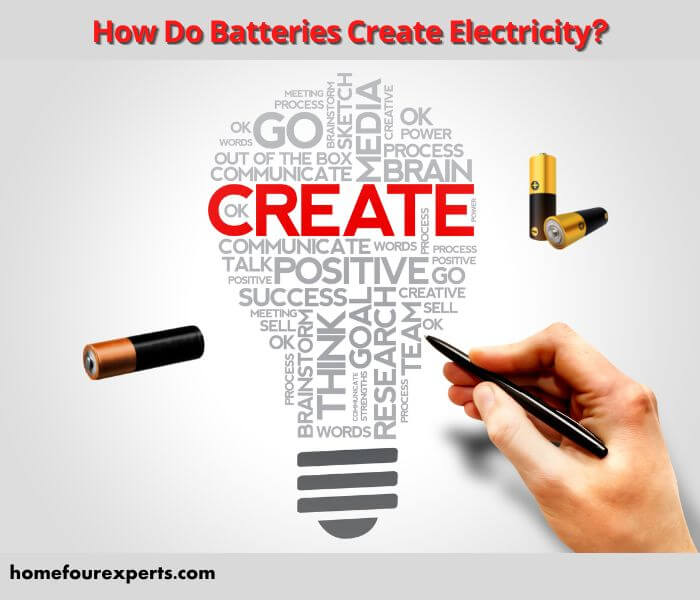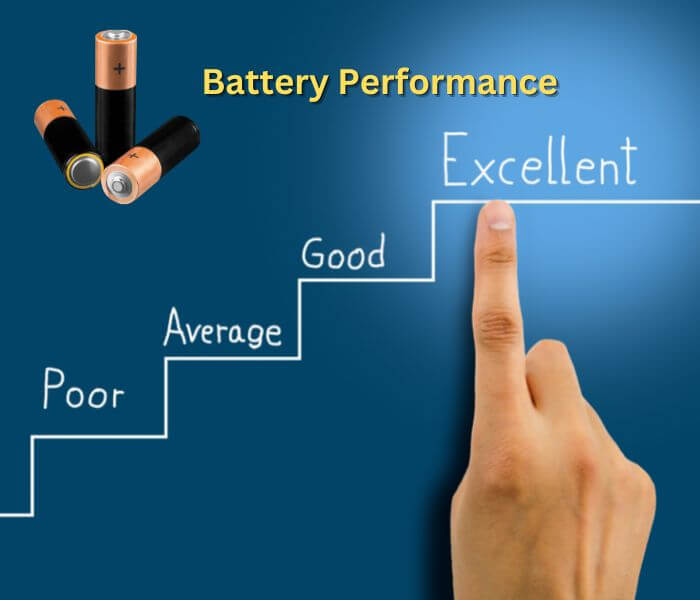Published on: January 21, 2023
Written by Liam Jaxon / Fact-checked by David Rowan
Welcome to our blog! Today, we’re exploring the fascinating topic of how batteries create electricity. From the humble everyday AA battery to an industrial-sized powerhouse, batteries are integral to how we power our lives. We’ll look at how batteries store energy, the science behind their construction, and their use in everyday applications. So, get ready to learn all about the miracle of electricity created by batteries!

Definition of a Battery
Batteries are a common source of electricity in our everyday lives, but have you ever wondered how they work? A battery is essentially a device that stores and produces electrical energy. A battery is made up of one or more cells, each of which contains two electrodes.
One electrode is called the anode and one electrode is called the cathode. Between the electrodes is an electrolyte, which is a solution that allows ions to move from one electrode to the other.
When a battery is connected to a device, a chemical reaction begins. This reaction causes electrons to flow from the anode to the cathode, creating electricity. The electricity produced is then used to power the device connected to the battery.
Explanation of the Chemical Reaction That Causes Electricity
Have you ever wondered how a battery is able to create electricity? It’s actually quite simple! Batteries create electricity through a chemical reaction known as an oxidation-reduction (or redox) reaction. These reactions involve the transfer of electrons between two materials.
Inside a battery, the two materials are typically a metal (such as zinc) and an electrolyte (such as sulfuric acid). When the two materials come into contact with each other, the electrons flow from the metal to the electrolyte, creating an electric current.
This current can then be used to power electrical devices. In short, it’s the chemical reaction between the two materials that creates the electricity needed to power your devices.
History of Batteries
Batteries have been around since the 1700s, revolutionizing the way we power our lives ever since. But how do batteries create electricity? It’s an interesting story.
Batteries produce electricity through a process called an electrochemical conversion. This occurs when two different metals are placed in an electrolyte solution, creating a chemical reaction that produces a direct current.
This current can then be used to power a variety of electrical devices. The most common battery today is the lead-acid battery, which consists of two electrodes (positive and negative) made from lead and a sulfuric acid electrolyte solution. When the battery is connected to an electrical circuit, electrons flow from the negative to the positive terminal, creating electricity.
Types of Batteries
Batteries are the unsung heroes of our modern world. We rely on them to power countless devices, from our cell phones to our cars.
But how do they work? The basic principle behind batteries is that they convert chemical energy into electrical energy. Inside a battery, two different metals are immersed in an electrolyte solution.
When a circuit is completed, electrons flow from one metal to the other, creating an electric current. This current is then used to power whatever device the battery is connected to. Batteries come in all shapes and sizes, and the type of battery used for a particular application depends on the device and the amount of energy it needs.
Primary Batteries (Non-Rechargeable)
Batteries are a source of electricity that can power almost anything from toys to flashlights. Primary batteries are a type of battery that is non-rechargeable and are used to create electricity through a chemical reaction.
The chemical reaction in primary batteries converts chemical potential energy into electrical energy. This conversion of energy happens when two different metals, such as zinc and manganese, come into contact with an electrolyte solution.
The electrolyte solution acts as a bridge between the two metals, allowing electrons to flow between them and generating an electric current. When the metals are connected to an electrical circuit, this current can be used to power devices.
Secondary Batteries (Rechargeable)
Batteries are amazing tools that have revolutionized the way we power our devices. In the most basic terms, a battery is a device that is capable of converting stored chemical energy into electrical energy.
This process is made possible by a series of chemical reactions that take place within the battery. When a battery is connected to an external device, electrons are able to flow from the positive side of the battery to the negative side.
This flow of electrons is what creates electricity. Batteries are often classified into two main types: primary and secondary. Primary batteries are single-use and cannot be recharged, while secondary batteries are rechargeable.
Lithium-Ion Batteries
Lithium-ion batteries are the most common type of rechargeable battery today, powering devices from smartphones and laptop computers to electric vehicles. But how do these batteries actually create electricity? In short, it all comes down to a chemical reaction.
Inside a lithium-ion battery, two electrodes (a positively charged anode and a negatively charged cathode) are immersed in an electrolyte solution. When the battery is connected to an external circuit and a current is applied, lithium ions move from the anode to the cathode.
This movement creates an electrical current that powers the device. When the battery is recharged, the lithium ions move back to the anode, allowing the battery to be reused.
Alkaline Batteries
Have you ever wondered how batteries create electricity? Alkaline batteries are one type of battery that utilizes a chemical reaction to generate electricity. This technology is used in a variety of applications, from powering toys and remote controls to providing backup power for computers and other electronics.
The process begins with two different metals submerged in an electrolyte solution that helps to facilitate the flow of electrons. The metals act as electrodes, and when a device is connected to the battery, electrons flow from the negative electrode to the positive electrode.
This flow of electrons creates the electricity that powers the device.
Battery Composition
Batteries are a key component in our daily lives. From powering our smartphones to powering our cars, batteries are the source of electricity for many of our gadgets and devices.
But have you ever wondered how batteries create electricity? Well, the answer lies in the composition of the battery itself. Batteries consist of three main components: an electrolyte, a cathode, and an anode.
When the electrolyte is mixed with the cathode and anode, a chemical reaction occurs that produces an electric current. This electric current is then used to power the device connected to the battery. In summary, batteries work by creating an electric current through a chemical reaction of the electrolyte, cathode, and anode.
Components of a Battery
Batteries are a complex yet interesting technology that allows us to easily store and use electricity. At its core, a battery is composed of two different elements; an anode and a cathode.
When these two elements are connected by an electrolyte, a chemical reaction occurs that allows the battery to produce electricity. This reaction is enabled by the movement of ions, which are electrically charged particles, from one element to another.
As the ions move, electrons are released, creating a flow of electricity. This electricity is then able to power our electronic devices.
Explanation of Each Component
Batteries are one of the key components to creating electricity. They are composed of two or more electrochemical cells that convert stored chemical energy into electrical energy.
When connected in series, the cells create higher voltages and when connected in parallel, the cells create higher currents. In a battery, the stored energy is then converted into electrical energy through a chemical reaction between the positive and negative electrodes.
This reaction creates a flow of electrons and the electrical energy is then available for use. Batteries are incredibly useful for powering a variety of electronic devices and are found in many everyday items like cell phones, watches, and cars.
Different Types of Metals and Their Roles in the Battery
Batteries are essential components of our lives, providing a convenient and reliable source of electricity. But how do they create electricity? By harnessing the power of different metals.
Different metals have different roles in the battery, each contributing to the production of electricity. For example, the anode is typically made from lithium, which generates the electrons that flow to the cathode.
The cathode is usually made from cobalt oxide and provides an area for the electrons to flow to, creating the electrical current. Other metals such as aluminum, nickel, or zinc can also be used in the battery to help store and release energy. Each metal has its own unique characteristics that make it useful in the battery and all of them work together to create the electrical current.
Battery Performance
Batteries are a key component of modern technology, powering everything from cell phones to electric cars. But how do batteries actually work? At their core, batteries are devices that store and convert chemical energy into electrical energy.
Inside a battery, chemicals react with each other and create electrical energy, which is then sent out through electrical terminals. This reaction is known as an electrochemical reaction, and it’s what makes batteries so powerful and efficient.
By controlling the reaction, batteries can generate a wide variety of voltages and currents, making them incredibly versatile. So next time you pick up your phone, car, or laptop, thank the battery for its role in powering your device!

Factors that Affect Performance
Our modern world runs on electricity, and batteries are an essential part of this equation. But how exactly do batteries create electricity? To understand this, it’s important to know the factors that affect battery performance.
Batteries are able to produce electricity due to a chemical reaction between two different materials. This reaction occurs when the positive and negative electrodes (made of materials like carbon, zinc, and lithium) are separated by an electrolyte, which carries ions between the two electrodes.
As electrons move between the electrodes, a voltage is created. The voltage created is determined by the difference in the materials used in the electrodes and the type of electrolyte used. Temperature also plays a role in battery performance, as higher temperatures can speed up the chemical reaction, while lower temperatures can slow it down. Finally, the amount of charge in the battery also affects performance, as lower charges can reduce the amount of current produced. By understanding the factors that affect battery performance, we can better understand how batteries create electricity.
How to Improve Performance?
Batteries are a reliable and effective way to store and produce electricity. They are used in a wide variety of applications, from powering small electronics to providing backup electricity during outages.
But how exactly do batteries create electricity? To understand this, it’s important to first look at how a battery is constructed. A battery consists of one or more cells, each of which contains two electrodes.
One electrode is made from a material that can donate electrons, while the other is made from a material that can accept electrons. When the two electrodes are connected, a chemical reaction occurs between them, generating an electrical current. This current can then be used to power anything from an LED light bulb to a laptop computer. By understanding how batteries create electricity, we can learn how to improve their performance and make them more efficient. This may involve using different materials, adjusting the number of cells, or making modifications to the design. With the right modifications, batteries can become a powerful and reliable source of energy.
How to Extend Battery Life?
Batteries are a crucial part of our lives. They power our electronic devices and enable us to stay connected.
But how do batteries work? In short, batteries create electricity by transforming chemical energy into electrical energy through a process called electrolysis. During electrolysis, electrons from the battery’s chemical reaction flow through a circuit and back to the battery, thus providing an electrical current.
This current is used to power our devices and also to recharge the battery. By understanding the process of electrolysis, we can learn how to increase the life of our batteries and keep our devices running longer.
Summary of How Batteries Create Electricity
A battery is a device that stores energy and converts it into electricity. Inside a battery, chemical reactions take place that produces electrons, which are then released and flow through a circuit.
This flow of electrons is what creates the electricity that powers all kinds of devices, from cell phones to cars. Batteries are made up of two different kinds of metal, called electrodes, that are submerged in a chemical solution.
When electrons move from one electrode to the other, energy is created in the form of electricity. This energy can then be used to power all sorts of things, from small electronic devices to large industrial applications.
If you want to know how do batteries hold a charge? The reply is here.
Benefits of Knowing How Batteries Work
Having a basic understanding of how batteries work can be incredibly useful, especially in today’s world of electronic devices. Batteries are the powerhouse of our modern world, providing us with the electricity we need to power our phones, laptops, and other devices.
But what exactly is it about batteries that make them so useful? To answer this question, let’s take a closer look at how batteries create electricity. At the most basic level, batteries create electricity through a chemical reaction.
Inside most batteries, you’ll find two metal plates. These plates are separated by a substance called an electrolyte. When the two metal plates come into contact with the electrolyte, a chemical reaction occurs. This reaction produces electrons, which can be used to power our devices. The type of battery you use will affect how much power it can produce and how long it can last.
For example, a lead-acid battery is typically used in cars and can provide a lot of power over a long period of time. On the other hand, a lithium-ion battery is used in many electronics and can provide a lot of power in a short burst. By understanding how batteries create electricity, you can better understand the devices you use and how to get the most out of them. Knowing how batteries work can also help you troubleshoot any issues you may have with your devices. So next time you’re looking for a new battery, make sure you have a basic understanding of how it works.
Safety Precautions When Handling Batteries
Batteries are a common source of electricity, providing power to an array of everyday items such as phones, laptops, and cameras. But when handling batteries, it is important to take safety precautions to ensure that you and your equipment stay safe.
Batteries create electricity through a chemical reaction between two electrodes, one being positively charged and the other negatively charged. As the electrons move between the electrodes, electricity is created and stored in the form of chemical energy.
This electricity can be released when the battery is connected to an electrical circuit. To ensure safety when handling batteries, it is important to always follow the instructions that come with the battery and to wear protective gear such as safety glasses and gloves. Additionally, only use batteries that are rated for the device you are using them in, and never mix and match different types of batteries.
Final Words
Batteries create electricity through a chemical reaction between two electrodes, one positively charged and one negatively charged, separated by an electrolyte. The flow of electrons from the negative electrode to the positive electrode generates an electrical current, which can be used to power devices.
Different types of batteries use different materials for the electrodes and electrolytes, which can affect the performance and lifespan of the battery.
About This Writer

Hi, I am responsible for the 'Homeowners Power Solutions' category. My name is Liam Jaxon and a licensed technician with 7 years of experience in vehicle batteries, electrical gadgets, and home appliances. My working experience in different residential & light commercial electrical sectors and the automobile industry helped to acquire vast knowledge in this industry.